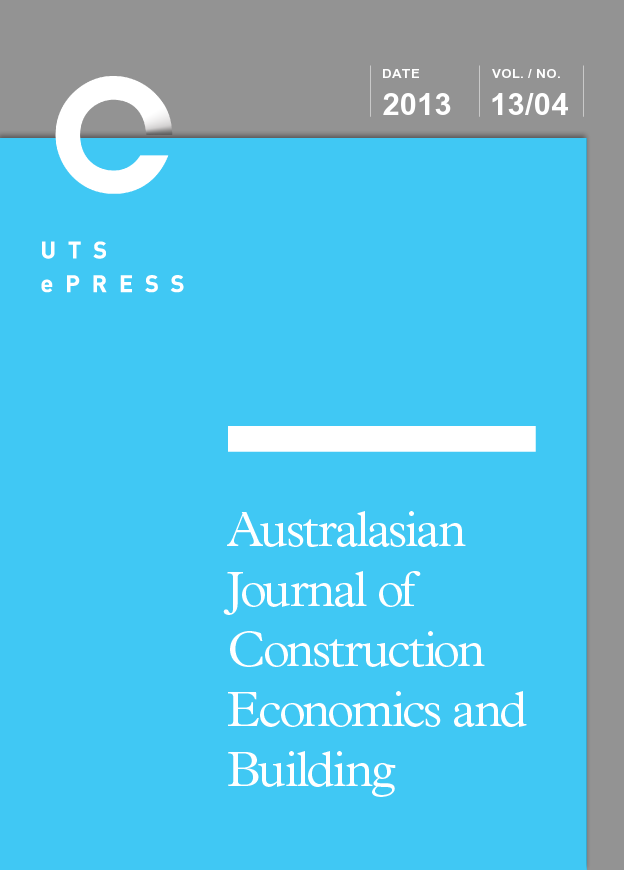The role of effective communication in the construction Industry: a guide for education and health clients
Main Article Content
Abstract
The construction industry operates primarily as a system of sub-contracting and purpose built alliances. There is a wide spread of stakeholders involved in conceiving a building project through typical stages such as design, finance, build, manage, upgrade and, ultimately, replacement and a corresponding need for communication and cooperation. Specialists who can prevent bridges falling down or who build 20 storey buildings are seen as the hard-nosed, action people who have helped bring us into the modern era. However, there are intuitive activities and disciplines which help us to achieve the type of construction achievements that have been the hallmarks of the 19th, 20th and now the 21st centuries. Most of these so called soft disciplines are about how one helps people, often highly skilled, achieve those construction and engineering goals. The key components are consultation and communication.
Communication strategies should be based on a thorough understanding of the ways that humans co-operate in joint undertakings, the key principles of social dynamics and learning theory plus the ways in which people deliver, accept and understand words and pictures. The disciplines of organisational and environmental psychology have become a basic fundamental of modern business activities from management and organisational strategy to marketing and customer relations and to the improvement of working, recreational and living environments.
However it is rare for a mature industry such as construction to adopt or examine those disciplines for guidance about either strategies or operations. This is despite the fact that the construction industry is almost entirely based on the principle of sub-contracting, business and professional alliances, all of which require understanding of environmental psychology and social dynamics in order to build trust, reputation, teamwork and client satisfaction. There is therefore a major need for communications to be systematic, understood by all stakeholders and intelligently applied. This paper concentrates on the need for the client to become a more confident and better informed stakeholder in the construction project, and seeks to provide high level management guidance for traditional centralized systems. The ultimate goal of the paper is to provide a systematic guideline for stakeholders to address early in the life of a project to ensure that industry professionals, clients and sub-clients are “working from the same page”
Article Details
Section
Authors who publish with this journal agree to the following terms:
a) Authors retain copyright and grant the journal right of first publication with the work simultaneously licensed under a Creative Commons Attribution License that allows others to share and adapt the work with an acknowledgement of the work's authorship and initial publication in this journal.
b) Authors are able to enter into separate, additional contractual arrangements for the non-exclusive distribution of the journal's published version of the work (e.g., post it to an institutional repository or publish it in a book), with an acknowledgement of its initial publication in this journal.
c) Authors are permitted and encouraged to post their work online (e.g., in institutional repositories or on their website) prior to and during the submission process, as it can lead to productive exchanges, as well as earlier and greater citation of published work (See The Open Access Citation Advantage Service). Where authors include such a work in an institutional repository or on their website (ie. a copy of a work which has been published in a UTS ePRESS journal, or a pre-print or post-print version of that work), we request that they include a statement that acknowledges the UTS ePRESS publication including the name of the journal, the volume number and a web-link to the journal item.
d) Authors should be aware that the Creative Commons Attribution (CC-BY) License permits readers to share (copy and redistribute the work in any medium or format) and adapt (remix, transform, and build upon the work) for any purpose, even commercially, provided they also give appropriate credit to the work, provide a link to the license, and indicate if changes were made. They may do these things in any reasonable manner, but not in any way that suggests you or your publisher endorses their use.
How to Cite
References
Australian Standard Method of Measurement, 1990, 5th edition, The Australian Institute of Quantity Surveyors and the Master Builders' - Construction and Housing Association Australia, Inc. Deakin, ACT
Best Practice Cost Estimation for Publicly. Funded Road and Rail Construction, Sep 2011
Estimation Standard for Publicly Funded Road and Rail Construction, Canberra, Government Printing Service
Orgill, Brad November 6th, 2010, The Australian
Building the Education Revolution Implementation Task Force, 2011, Canberra, ACT http://www.bertaskforce.gov.au/pages/default.aspx
Sunindyo, R.Y, Zou, Patrick X.W., 2013, 'The Roles of Emotional Intelligence, Interpersonal Skills and Transformation Leadership on Improving Construction Safety Performance', Australasian Journal of Construction Economics and Building, 13 (3), 97-113
Uher, Thomas E and Davenport, Philip, 2009, 2nded, Fundamentals of Building Contract Management, Sydney UNSW Press
Zou, Patrick X.W, Guomin Zhang and Jia âYuan Wang Identifying Key Risks in Construction Projects: Life Cycle and Stakeholder Perspectives, www.prres.net/papers/zou_risks_in_construction_projects.pdf
